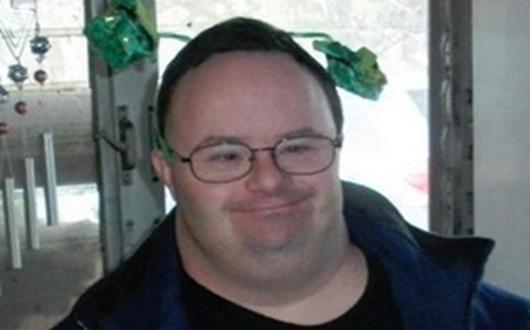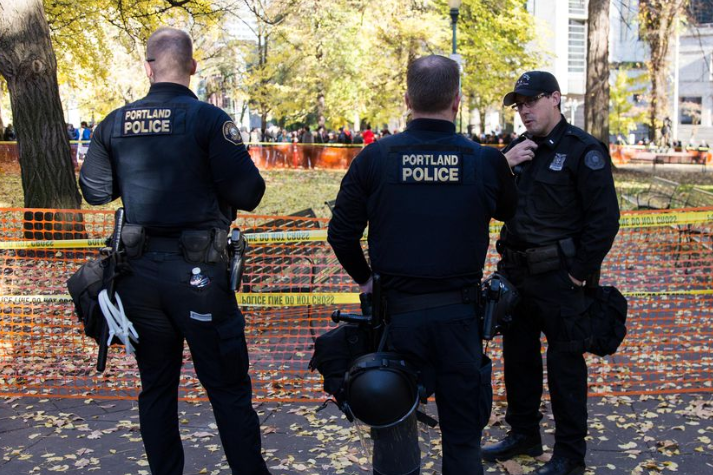5.1 Chapter Overview and Learning Objectives
As people with mental disorders are increasingly living in communities without proper treatment and support to succeed, they are more likely than ever to come into contact with law enforcement (figure 5.1). Consequently, police departments have had to change how they address people in the community with mental disorders and developmental disabilities. The tragedy explained in figure 5.1 describes an incident involving a Black man diagnosed with schizophrenia who was recently released from the hospital and went to a private residence asking for help. When police were called, a struggle ensued and the man was fatally shot by police. The public has placed a great deal of scrutiny on police departments and the inherent power differential in police-community member interactions that can cause harm to marginalized people, especially. Throughout this chapter, we will consider how policing has shifted over the years with respect to engaging people with mental disorders and identify areas for growth in these interactions.
(Figure 5.1) Listen to or read about how this news article explains how law enforcement has inherited tasks to manage mental disorders in the communities they police.
5.1.1 Learning Objectives
Upon completion of this chapter, you will be able to:
- Explain how policing in the community has changed in response to increases in demands related to mental disorders.
- Describe best-practice guidelines and strategies for managing law enforcement encounters involving people with mental disorders.
- Summarize current law enforcement training and workload status with respect to people with mental disorders in Oregon.
- Compare and contrast intervention and crisis response offered by law enforcement and by policing alternatives.
- Recommend strategies to improve officer interactions with people with developmental disabilities.
5.1.2 SPOTLIGHT: Deaths of James Chasse and Ethan Saylor
The risk of being killed in a police interaction in the community is sixteen times higher for a person with untreated serious mental illness than for the average person (Fuller et al., 2015). It is estimated that half of the people killed by police have some kind of disability, many of them a psychiatric disability (Hause & Melber, 2016). According to the advocacy organization Vera, in 2021 alone, at least 104 people were killed by police who were responding to calls involving a mental health crisis or erratic behavior (Turner, 2022).
5.1.2.1 James Chasse
Positive social change often doesn’t happen until there is a tragedy, and that is exactly what happened with Portland’s approach to those who suffer from severe mental illness. In the summer of 2006, James Chasse was a 42-year-old man diagnosed with schizophrenia. He lived in an apartment in downtown Portland, and he had stopped taking his medications. By the time officers encountered him on September 17th, he had likely been off of his medication for several weeks.
The officers perceived an unarmed Chasse to have been doing something “suspicious,” and Chasse fled when they approached him. Three law enforcement officers then brutally attacked Chasse while they attempted to pin him to the ground. He was tased multiple times, and kicked and punched into submission. Chasse was finally hogtied face down in a crosswalk (figure 5.X)

Figure 5.2. This photo shows James Chasse on the sidewalk in Portland, surrounded by police.
Ultimately, Chasse had 26 fractures in 16 of his ribs, he had a punctured lung, his spleen was torn, and one of his collar bones was broken. Two forensic nurses at the jail refused to admit Chasse due to his injuries, and jail staff told police to transport him instead to a hospital. Chasse died en route. Later investigations showed that it took 106 minutes from the time the police first confronted Chasse until he died.
Five hundred people attended a memorial for James Chasse, and there was an outcry across Oregon. There were hundreds of news stories about the case, and civil rights and health advocates demanded change. The three officers involved in the fatal beating were not held legally accountable following an internal investigation into the incident.
While not immediate, positive change did occur as a result of Chasse’s death in 2011. The Crisis Assessment and Treatment Center opened in Multnomah County, which has a 16-bed capacity to help stabilize patients in crisis. In 2012, at the conclusion of another investigation into the Portland Police Bureau, the U.S. Department of Justice found that there was a history of excessive force used against those with mental disorders. This resulted in more police training and accountability, and funding for Assertive Community Treatment (ACT) teams across Portland.
5.1.2.2 Ethan Saylor

Figure 5.3 is a photo of Ethan Saylor.
On January 12, 2013, Ethan Saylor (26) and his caregiver sat for a showing of “Zero Dark Thirty” in a Maryland movie theater. Ethan, who loved church, guitars, and police officers, had been born with Down Syndrome (figure 5.3)
When the movie ended, Ethan’s caregiver told him to wait for her while she went to get the car. While the caregiver was gone, Ethan wandered back to his seat in the theater and thought he might like to watch the movie a second time.
The theater manager contacted mall security. That day, three sheriff’s deputies were working a special detail, providing security at the facility. They told Ethan he needed to leave, but Ethan resisted. The manager would not allow Ethan’s caregiver to go to him and assist with the situation—which likely would have diffused the whole thing—and instead the deputies decided to force Ethan out of his seat. The situation escalated quickly.
Witnesses reported that one deputy had his knee in Ethan’s back as they tried to cuff him. Ethan called out, “Mommy, it hurt!” He soon stopped breathing and the injuries he sustained proved fatal.
In the wake of Ethan’s needless death came great social change. Then-Maryland Governor Martin O’Malley established the Commission on Effective Community Inclusion of People With Intellectual and Developmental Disabilities. Members of this Commission came from law enforcement agencies, state agencies, and family members of those with intellectual and developmental disabilities. They were invited to make recommendations for training law enforcement officers to more effectively handle their encounters with DD/ID individuals. From this Commission the Ethan Saylor Alliance was born. Now, people with developmental or intellectual disabilities, themselves, take part in training programs for law enforcement officers. The Alliance has been in operation since April of 2015.
5.1.3 Licenses and Attributions for Chapter Overview
“Chapter Overview” by Kendra Harding is licensed under CC BY 4.0.
Figure 5.1. OBP Article: The Safety Net Is Broken: How Police Became Mental Health First Responders – OPB
Figure 5.1. “Occupy Portland: Day 1” by Eli Duke, Flickr is licensed under CC BY-SA 2.0.
Pedagogical element written by Monica McKirdy.
Figure 5.3 Photo of Ethan Saylor https://www.flickr.com/photos/4wardever/34244462844
Figure 5.2. Photo of James Chasse by Jamie Marquez, Portland Mercury is included under fair use.
Figure 5.3 Photo of Ethan Saylor by 4WardEverUK, Flickr is licensed under CC BY-NC-ND: 2.0

